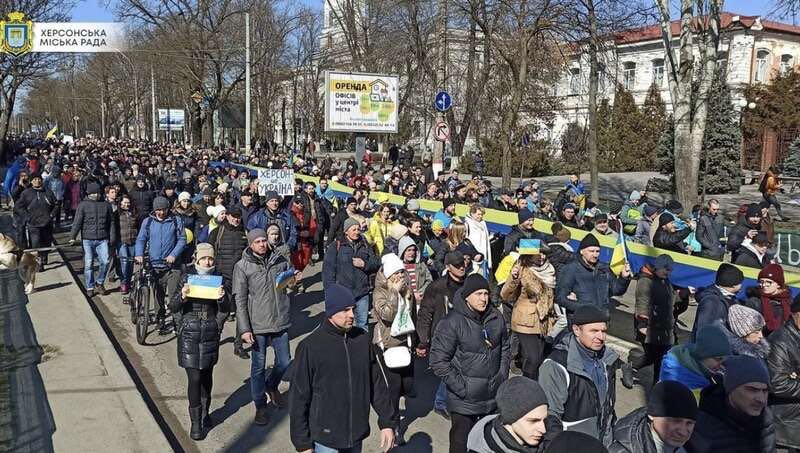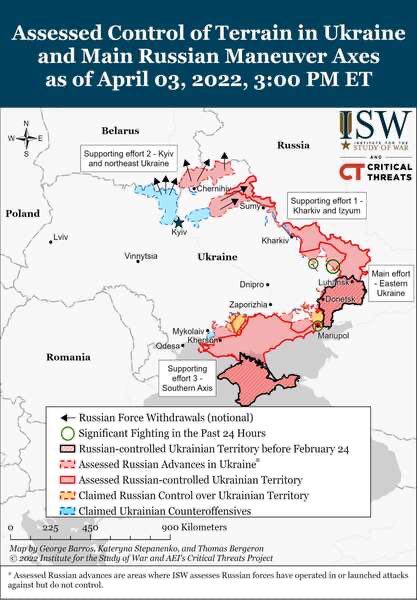Now that Russia's invasion in Ukraine has entered its second month, a long-term occupation in southern Ukraine becomes a realistic scenario. Ivan U. Klyszcz, specialist on Russian foreign policy investigated for Riddle what is known about life in Ukraine's newly occupied territories. He writes that Russia attempts to create new puppet ‘pseudo-republics’ in the fashion of the Luhansk and Donetsk ‘People’s Republics’.
 Citizens of Kherson protest against occupation (picture Twitter).
Citizens of Kherson protest against occupation (picture Twitter).
by Ivan U. Klyszcz
Russia may be pursuing long-term occupation in its re-invasion of Ukraine. In January 2022, Russian military expert Michael Kofman argued that long-term occupation of Ukraine would be among Russia’s military objectives. Now the war is ongoing, signs that Russia intends to hold what it has captured so far are multiplying. Indeed, on 13 March, President Zelenskyy denounced Russia’s attempts at establishing new puppet ‘pseudo-republics’ in the fashion of the Luhansk and Donetsk ‘People’s Republics’. Until liberation, hundreds of thousands now face an occupation regime by a hostile power. What is happening in these new occupied territories?
Amid the fog of war, reliable news from the newly occupied zones are rare. The occupation regime has targeted Ukrainian government officials, journalists and society in general, keeping them from resisting or speaking out. Journalists, fixers and reporters have been allegedly targeted by the Russian forces since the beginning of the re-invasion. There are reports of many being detained by the occupation regime. Yet some local media outlets continue to operate. Their work manages to cover some of the activities of the occupation regime and the moves of the Ukrainian military. Thanks to their work, we can piece together a rough picture of Russia’s sham state-building in its re-invasion of Ukraine.
Occupation has gone beyond military expediency as the Russian forces have sought to create administrations pliable to their goals. As new information surfaces, the evidence is mounting that Russia’s purpose is to roughly follow the Donbas scenario and establish long-term puppet occupation regimes.
 Russian positions on April 3 (source: Institute for the Study of War)
Russian positions on April 3 (source: Institute for the Study of War)
Brutal military regime
Like in other occupied regions of Ukraine, the newly occupied territories feature heavy Russian military control. Occupation has given the Russian military new operational scope for the war. For instance, Russian forces have been busy building installations in Kherson oblast. Curfews have been imposed throughout the population centres occupied by Russia. Protests and all public gatherings are banned. These prohibitions are enforced not necessarily by the Russian army but by police forces and paramilitaries brought from Russia—including the Kadyrov and Rosgvardia paramilitary forces. Several protestors have been killed, shot at by these occupying forces.
Like a twenty first century Smersh (soviet military counter-intelligence during the second world war), there are also reports that the occupying forces are sweeping population centres, looking to harass Ukrainian veterans, activists and those loyal to the Ukrainian state. Even teachers and orchestra directors have been reported missing. Persecution of Crimean Tatars is being reported. The fate of those caught by the Russian checkpoints and sweeps is not known exactly. But torture and threats to their lives frequently appear in testimonies. Some even report forced transfers to Luhansk and Russia. By mid-March, Ukrainian authorities reported over 400 individuals missing in occupied Kherson oblast.
Sham state-building
This brutal military regime is supplemented with the instruments for sham state-building, not dissimilar from that of the Donbas ‘People’s Republics’. Several such puppet governments may be in store. On 12 March, the Ukrainian government accused Russia of planning to carry out a sham referendum in Kherson along the lines of Crimea in 2014. Not only is there a name for these so-called republics, but the Kherson one even has an ‘independence day’ proclaimed, 13 March. These proclamations point to Russia aiming to project a dual civilian and military rule over the ‘liberated’ territories.
These ambitions have put the existing civilian authorities in a vulnerable position. Throughout the occupied towns and cities, civilian authorities have remained loyal to Ukraine and pledged to continue service provision as before — that is, without taking orders from the occupation regime. Reports suggest that the Russian military is not imposing demands on municipalities directly but systematically replacing local governments with puppet administrators. Those who do not cooperate are kidnapped, as happened to the mayor of Melitopol, Ivan Fyodorov. Similar cases have been reported in Nova Kakhovka, Beryslav, and elsewhere. Other elements of public administration are being replaced as well. In Nova Kakhovka, the occupation regime reportedly dismissed the town’s entire police force.
Russification
Slowly, collaborationists emerge. On 16 March, RT released a — likely staged — video showing the supposed formation of a new authority for the Kherson region, supposedly established on the 10th of March. (Curiously, the occupation regime signed its directives with a generic ‘civic-military administration’ as late as 15 March.) According to Russian media, the ‘Rescue Committee for Peace and Order’ consists of ‘pro-Russian’ activists, and it has assigned itself the authority to trace the political course of Kherson oblast. The plan was clear from the first day: to ‘converge‘ with Russia and Crimea. In Zaporizhzhya, a similar ‘civic-military’ authority has been established in Melitopol, meant to follow in the steps of the Kherson one. Other such puppet regimes are in store, with Kherson leading the way as it is the only region mostly under Russian control. These and other collaborationists are under investigation by the Ukrainian authorities for treason.
Indeed, replacing civilian administrators with collaborationists is a strategy we witnessed before in Russia’s Donbas occupation. Like in Donbas, further steps to entrench the occupation have been taken. Reports surfaced in late March that the occupation regime may be planning to introduce the ruble as currency in Kherson oblast in April. Then, Russian television channels may be operating now, with the purpose to assist the occupation. Accordingly, on 13 March, the Melitopol ‘civilian’ occupation regime called the population to tune into Russian television channels to ‘get the truth’ about what is happening in the area. Further, reports have emerged that schools in Melitopol will continue to operate but will switch to Russian language teaching from 1 April. Finally, disturbing reports have surfaced that occupation forces may be destroying some Ukrainian-language history books from captured libraries.
These attempts at co-opting and coercing a public administration into being have not resulted in real governance. Indeed, the humanitarian situation has deteriorated significantly since occupation began. Access to food became uncertain from the very start. Reports have emerged of Russian forces turning away humanitarian aid from Ukrainian sources to occupied territories. Humanitarian aid has supposedly arrived from Chechnya and Crimea but their scale is inadequate—if indeed they ever arrived. The Ukrainian government has since issued a statement about the humanitarian situation in occupied Kherson as approaching a humanitarian disaster as food and essential medicines become scarce. Some shopping centres continue to operate, but the long queues reported point to the precarious state of food access for the population of the region.
Signs of long-term occupation
Now that the re-invasion is in its fifth week, signs of long-term occupation are mounting. This can indeed be an outcome of the war. As Lawrence Freedman wrote on 9 March, if a cease-fire is imposed under the principle of ‘keep what you hold’, Russia could retain its hold over several new parts of Ukraine. Indeed, the flipside to Russia’s unexpectedly high estimated losses may be less of a disposition to give up the territories taken through massive costs and bloodshed. This would create new de facto borders where the frontline stands. The negotiations have mostly focused on Ukraine’s neutrality status, leaving the fate of the occupied territories to future consultations. Even then, discussions have mostly surrounded Crimea, Donetsk and Luhansk, leaving open the question on the newly occupied territories.
As shambolic as Russia’s war efforts have been, it is possible to speculate that these ‘state-building’ efforts were already planned from the start. Prior to the re-invasion, the FSB Ninth Directorate reportedly carried out surveys in Ukraine to assess public sentiment towards known figures that would function as the occupation’s puppet regime. In spite of these and subsequent efforts, Ukrainian resistance — inside and outside the occupied territories — is hindering Russia’s occupation regime from taking shape. In fact, the ongoing Ukrainian counter-offensive has rendered Kherson into a contested city. But, Moscow’s intent is clear, and only the full liberation of the occupied territories will stop the creation of the would-be puppet regimes.
